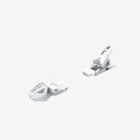2025 Head e.pure Joy
The Pure Joy is THE women's ski for Beginner to intermediate skiers, thanks to HEAD's Better Balance Technology, which makes the ski forgiving, versatile and easy to turn by putting women in an optimum position. A lightweight core and 75 mm waist adds quickness on piste, while a new sidecut makes the ski forgiving and accessible to a wide range of skiers.
- LYT Tech Construction
- EMC F
- Graphene
- Women´s Camber
- Super Light Weight Distribution
- Power Sidewall Jacket Construction
- Synthetic Core
- UHM C Base
- Allride Rocker
- Plate: JOY "BB" SLR PRO Base
Beginner - Intermediate
- You are in this category if it’s your first time on the slopes, are developing basic skills like linking your turns, and getting on/off the chairlift. Beginner - intermediate skis will typically be constructed with narrower profile, softer materials, and cap construction, providing you with smooth easy turns and will be more forgiving overall.
All Mountain
- An all mountain ski is engineered to be dependable in most terrains you have in mind. This could include heavy snow, steeps, font-side groomers, ice, and powder. If you have one ski in your quiver, this would be a good choice.
Frontside Skis
- These high-speed carvers will typically have a narrower waist with a full camber profile; maximizing edge grip. Many of them will also have an integrated binding system organic to the ski. If you spend most of your time rocking it on the groomers, these might be right for you.
Rocker/Camber
- A rocker/camber profile keeps camber underfoot, storing and transmitting energy with the rear contact point remaining near the tail. An elongated, early rise, rockered tip moves the forward contact point medially, providing less edge catch and increased flotation in deeper snow.
System Skis with Integrated Bindings
- Skis that include integrated binding systems can be adjusted to most adult boot sole lengths and are compatible with Alpine (ISO 5355) and Gripwalk (ISO 9523) soles. These bindings will not come mounted; always have a qualified technician inspect your boots and bindings before they install, adjust, and function test your system.
- The DIN (Deutsches Institut für Normung) scale on your bindings is the ski industries’ adjustment range for the release force settings on your skis’ bindings. This number will be determined by your age, weight, height, boot sole length, and your skier type (I, II, or III; not your skier ‘ability’). This setting should always be adjusted by a qualified technician after a visual/tactile inspection and function test.
*If you’re unsure if your boots and bindings are compatible, please have a qualified technician give them a tactile and visual inspection.


